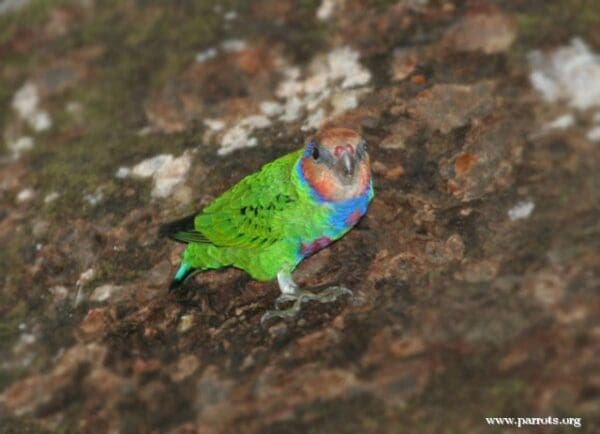Red-breasted Pygmy Parrot
Also known as:
Mountain Pygmy Parrot, Red-headed Pygmy Parrot, Bruijn's Pygmy Parrot
Also known as:
Mountain Pygmy Parrot, Red-headed Pygmy Parrot, Bruijn's Pygmy Parrot

Micropsitta

bruijnii
Size:
9 cm (3.5 in)
Weight:
12-16 g (0.4-0.6 oz)
Subspecies including nominate:
four: M.b. bruijnii, M.b. pileata, M.b. necopinata, M.b. rosea
Colour Adult:
M.b. bruijnii: Male-mostly green in colour; buff/red to brown/orange crown; deep blue nape and hindneck; line extending from nape to area behind eye and from hindneck as collar around to lower throat; blue on sides of breast, reaching to meet collar on neck; buff/orange throat and cheeks to ear coverts; pale red centre of underparts; blue central tail feathers; lateral tail feathers blue/black. Beak horn with grey at base. Cere and eye ring pink. Eye brown. Female-in general green, red markings absent; dark blue crown; pale off-white forehead and cheeks; blue on sides of breast, nape and hindneck absent. Cere and eye ring grey.
M.b. pileata: Male-brown/red on crown deeper and reaching farther down nape; narrow, blue nuchal collar. Female-undescribed.
M.b. necopinata: Male-deep brown crown, turning to pale yellow/brown in centre; red/orange cheeks, throat and centre of breast to abdomen; yellow undertail coverts. Female-as in bruijnii, but more purple/blue crown.
M.b. rosea: Male-bright red/pink crown; pinker and brighter cheeks and throat. Female-as in bruijnii.
Colour Juvenile:
M.b. bruijnii: As in adult female, but with white forehead and lores; some orange/red on underparts of males.
Call:
Calls are described as high-pitched short notes or series of short notes; some notes also shrill and penetrating.
More Information:
Content Sources:
CITES
BirdLife International
Cornell Lab of Ornithology/Birds of the World
Parrots: A Guide to Parrots of the World, Juniper and Parr, 1998
Parrots of the World, Forshaw and Cooper, 1989.
Lexicon of Parrots, Thomas Arndt.
Parrots of the World, Forshaw, 2006.
Captive Status:
Not found in captivity; difficult to keep alive for more than a few hours or days.
Longevity:
—
Housing:
—
Diet:
—
Enrichment:
—
Nest Box Size:
—
Clutch Size:
4
Fledging Age:
—
Hatch Weight:
—
Peak Weight:
—
Weaning Weight:
—
World Population:
Unknown but reported as uncommon to common. Decreasing.
IUCN Red List Status:
Least Concern
CITES Listing:
Appendix II
Threat Summary:
Not globally threatened. Considered uncommon to rare on Seram and Buru, but may be easily overlooked. Widespread but local in New Guinea; undescribed form at Ok Tedi appears to be common. Common locally in the Bismarck Archipelago. Is considered to have a medium dependency on forest habitat, and tree cover is estimated to have declined by 2% within its range over the past 10 years. Therefore, it is tentatively suspected that this may have led to a population decline of between 1-19% over the same time frame.
Range:
M.b. bruijnii: Mountains of New Guinea from Vogelkop, West Papua east to Owen Stanley Range, E Papua New Guinea. May be an undescribed subspecies in Ok Tedi River Region, W Papua New Guinea.
M.b. pileata: Mountains of Seram and Buru, S Moluccas, Indonesia.
M.b. necopinata: New Britain and New Ireland, Bismarck Archipelago.
M.b. rosea: Bougainville Island, E Papua New Guinea, and Kolombangara and Guadalcanal, Solomon Islands.
Habitat:
Found from 1000-2300 m (3280-7544 ft) in primary and secondary montane forest, along forest margins and in Albizia shade trees in coffee plantations.
Wild Diet:
Forages for fungi and lichens from undersides of branches; also fruits and flowers, possibly Schefflera.
Ecology and Behaviour:
Keeps to mid and upper canopy. Favours dead trees in which to find fungi and lichens. Seen in pairs or groups of up to 20 individuals.
Clutch and Egg Size:
4 rounded eggs, 17.5 x 14.0 mm (0.7 x 0.5 in).
Breeding Season:
December-April; nest is cavity in tree stump.
Related Links:
—







